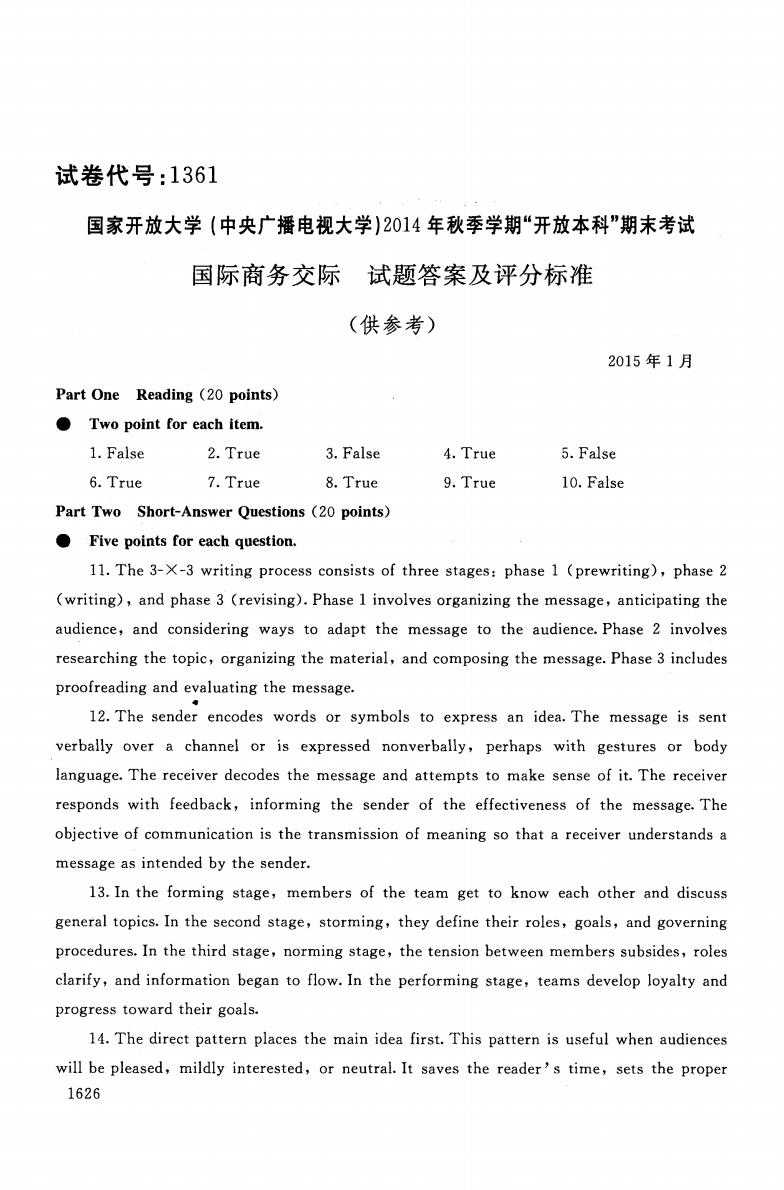正在加载图片...

试卷代号:1361 国家开放大学((中央广播电视大学)2014年秋季学期“开放本科”期末考试 国际商务交际 试题答案及评分标准 (供参考) 2015年1月 Part One Reading (20 points) Two point for each item. 1.False 2.True 3.False 4.True 5.False 6.True 7.True 8.True 9.True 10.False Part Two Short-Answer Questions (20 points) Five points for each question. 11.The 3-X-3 writing process consists of three stages:phase 1 (prewriting),phase 2 (writing),and phase 3(revising).Phase 1 involves organizing the message,anticipating the audience,and considering ways to adapt the message to the audience.Phase 2 involves researching the topic,organizing the material,and composing the message.Phase 3 includes proofreading and evaluating the message. 12.The sender encodes words or symbols to express an idea.The message is sent verbally over a channel or is expressed nonverbally,perhaps with gestures or body language.The receiver decodes the message and attempts to make sense of it.The receiver responds with feedback,informing the sender of the effectiveness of the message.The objective of communication is the transmission of meaning so that a receiver understands a message as intended by the sender. 13.In the forming stage,members of the team get to know each other and discuss general topics.In the second stage,storming,they define their roles,goals,and governing procedures.In the third stage,norming stage,the tension between members subsides,roles clarify,and information began to flow.In the performing stage,teams develop loyalty and progress toward their goals. 14.The direct pattern places the main idea first.This pattern is useful when audiences will be pleased,mildly interested,or neutral.It saves the reader's time,sets the proper 1626试卷代号 :1361 国家开放大学(中央广播电视大学 )2014 年秋季学期"开放本科"期末考试 国际商务交际 试题答案及评分标准 Part One Reading (20 points) • Two point for each item. 1. False 2. True 6. True 7. True (供参考) 3. False 8. True Part Two Short-Answer Questions (20 points) • Five points for each question. 4. True 9. True 2015 5. False 10. False 11. The 3- X -3 writing process consists of three stages: phase 1 (prewriting) , phase 2 (writing) , and phase 3 Crevising). Phase 1 involves organizing the message , anticipating the audience , and considering ways to adapt the message to the audience. Phase 2 involves researching the topic , organizing the material , and composing the message. Phase 3 includes proofreading and evaluating the message. 12. The sender -encodes words or symbols to express an idea. The message is sent verbally over a channel or is expressed nonverbally , perhaps with gestures or body language. The receiver decodes the message and attempts to make sense of it. The receiver responds with feedback , informing the sender of the effectiveness of the message. The objective of communication is the transmission of meaning so that a receiver understands a message as intended by the sender. 13. In the forming stage , mem bers of the team get to know each other and discuss general topics. In the second stage , storming , they define their roles, goals , and governing procedures. In the third stage , norming stage , the tension between members subsides, roles clarify , and information began to flow. In the performing stage , teams develop loyalty and progress toward their goals. 14. The direct pattern places the main idea first. This pattern is useful when audiences will be pleased , mildly interested , or neutral. It saves the reader' s time , sets the proper 1626